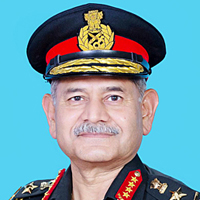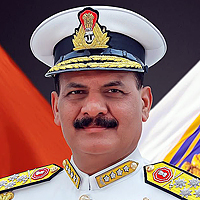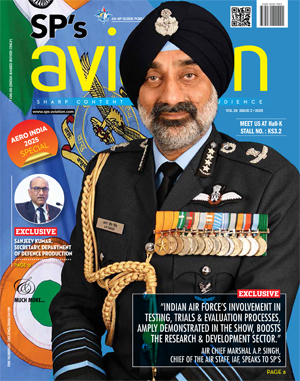INDIAN ARMED FORCES CHIEFS ON OUR RELENTLESS AND FOCUSED PUBLISHING EFFORTS

The insightful articles, inspiring narrations and analytical perspectives presented by the Editorial Team, establish an alluring connect with the reader. My compliments and best wishes to SP Guide Publications.

"Over the past 60 years, the growth of SP Guide Publications has mirrored the rising stature of Indian Navy. Its well-researched and informative magazines on Defence and Aerospace sector have served to shape an educated opinion of our military personnel, policy makers and the public alike. I wish SP's Publication team continued success, fair winds and following seas in all future endeavour!"

Since, its inception in 1964, SP Guide Publications has consistently demonstrated commitment to high-quality journalism in the aerospace and defence sectors, earning a well-deserved reputation as Asia's largest media house in this domain. I wish SP Guide Publications continued success in its pursuit of excellence.
Restructure DPP
Unless the DPP is simplified and radically restructured so as to address the imperatives of national security, modernisation of the Indian armed forces may remain a distant dream

At the end of December 2016, the government gave a small gift for the new year to the Indian armed forces by way of grant of approval to projects valued at Rs. 7,000 crore. The projects cleared relate to the procurement of defence hardware for the Indian armed forces. This helped elevate to some extent their spirits that have been inclined to reach the depths of despair more so in the Indian Air Force (IAF) in the last over a decadeand-a-half. Commencing in the mid-1980s, the IAF went through a major revamp of hardware especially in the regime of combat platforms. In this period, the IAF inducted MiG-27 and MiG-29 fighters from the Soviet Union and the Mirage 2000 fighters from Dassault of France. The IAF also received the Russian An-32 medium-lift transport aircraft and the Ilyushin IL-76 heavy-lift transport aircraft. All these platforms have been the mainstay of the IAF for over the last three decades and continue in service even now. What is noteworthy is that none of the platforms were acquired through the process of global or local tender; but through direct deals with the foreign government or the original equipment manufacturer (OEM). The process of acquisition in all these cases was speedy, smooth and remarkably free of scam. Acquisition of the Su-30 fighters from Russia was similarly negotiated at the end of the 1990s and induction of the platform began in 2002. All these platforms continue to be the backbone of the IAF’s combat fleet.
Trouble in defence procurement by the Indian armed forces, and especially by the IAF with regard to its fleet of combat aircraft, began soon after the collapse of the USSR. As the nation that had thus far been dependent largely on the USSR for the acquisition of military hardware, with the emergence of a unipolar world, fresh opportunities had opened up for the IAF to procure from Western nations, military aircraft and weapon systems endowed with advanced technologies. With the aim of providing a wider choice, the best value for money and eliminating the menace of financial impropriety, the Ministry of Defence (MoD) introduced a mechanism to regulate the process of acquisition of military hardware. Dubbed as Defence Procurement Procedure (DPP) crafted on the basis of the Defence Procurement Policy, this new provision has, as is usually the case with regulatory mechanisms of the government, proved to be more of an impediment rather than a facilitator. With the fleet of MiG-21 approaching obsolescence, in 2002, the IAF initiated a case in accordance with the DPP for the procurement of 126 medium multi-role combat aircraft (MMRCA). The global tender for this project was floated in August 2007 and after elaborate evaluation by the IAF, the Rafale from Dassault was declared as the platform of choice. Unfortunately, after 13 years of effort by the IAF, the project ran aground and in 2015, the tender was cancelled leaving the IAF in serious difficulty. Apart from the contract thereafter for 36 Rafale jets through direct deal with the French Government, action is now in hand to proceed through the government–to-government route to transfer the production line of yet to be selected combat platform to India for indigenous production for both the domestic and global markets.
Similarly, tender for the procurement of urgently required 197 light utility helicopters (LUH), floated in 2004 for which the Eurocopter AS-550 Fennec was selected, was cancelled in December 2007 apparently on account of allegations of irregularities in the process of selection as well as the involvement of middlemen which was not permitted under the DPP. The tender was floated for the second time in July 2008 by which time there was significant escalation in cost. However, once again there were allegations of wrongdoing in the processing of the tender leading to investigations by the MoD. Based on the findings, the second tender for the 197 LUHs was also cancelled. Incidentally, one of contenders in the race was the Russian Kamov Ka-226T which has been recently selected through a direct deal with the Russian Government for manufacture in India under the ‘Make in India’ programme. The third major global tender for aircraft to fail twice has been that for the acquisition of six Airbus A330 multi-role tanker transport aircraft from Airbus Defence and Space. It is understood that action is underway to procure an alternative platform from the US through a direct deal with the government.
From the experience so far of procurement of military hardware under the DPP, it is abundantly clear that unless the procedure is simplified and radically restructured so as to address the imperatives of national security and not merely to focus on restrictive provisions, rapid and effective modernisation of the Indian armed forces may remain a distant dream.





